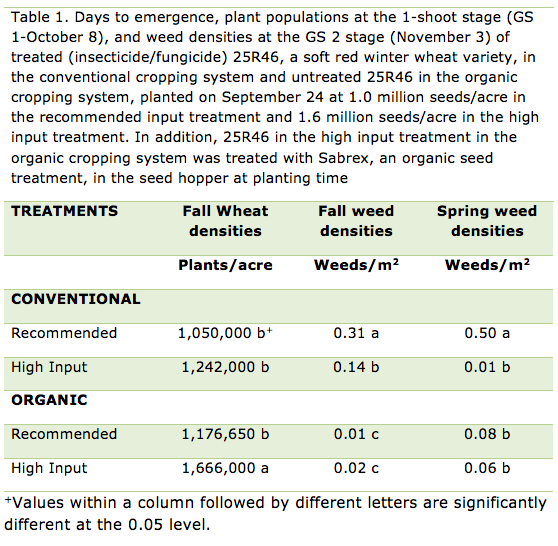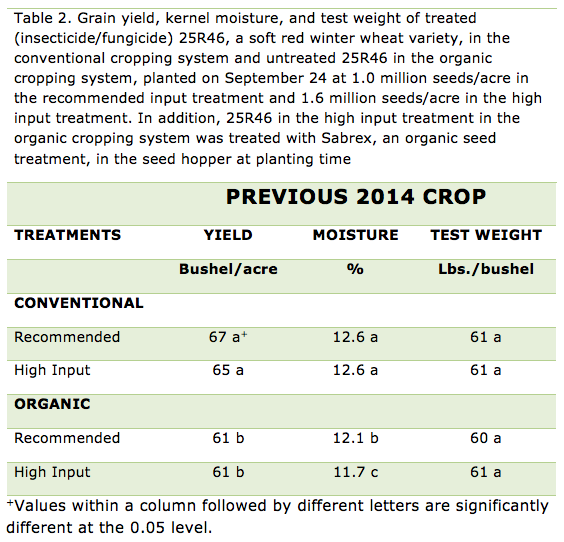By Bill Cox1, Eric Sandsted1, Jeff Stayton2, and Wes Baum2
1Soil and Crop Sciences Section – School of Integrated Plant Science, Cornell University; 2Cornell University Agricultural Experiment Station

We initiated a 3-year study at the Aurora Research Farm in 2015 to compare the corn, soybean, and wheat/red clover rotation with different crop sequences in conventional and organic cropping systems during the 3-year transition period (2015-2017) to an organic cropping system. Three of the many objectives of the study are to determine 1) the best entry or 1st year crop (2015) to plant during the transition, 2) the best crop sequence during the 3-year transition (soybean-wheat/red clover-corn, corn-soybean, wheat/red clover, or plowed in red clover-corn-soybean) and 3) do corn, soybean, and wheat respond similarly to management inputs (high and recommended) in conventional and organic cropping systems? This article will compare the agronomic performance of organic wheat with conventional wheat following soybean in a soybean-wheat/red clover-corn sequence during the second year of the transition from conventional to an organic cropping system.
We used a John Deere 1590 No-Till Grain Drill (7.5 inch spacing between drills) to plant the treated (insecticide/fungicide seed treatment) Pioneer soft red wheat variety, 25R46, in the conventional cropping system; and the untreated 25R46, in the organic cropping system at two seeding rates, ~1.2 million seeds/acre (recommended input) and ~1.6 million seeds/acre (high input treatment) on September 24, the day after soybean harvest. We applied about 200 lbs. /acre of 10-20-20 as a starter fertilizer to wheat in both conventional treatments. We also applied Harmony Extra (~0.75 oz. /acre) to the high input conventional treatment at the GS 2 stage (November 5) for control of winter perennials (dandelion in particular).
In both organic treatments, we applied the maximum amount of Kreher’s composted chicken manure (5-4-3 analysis), as a starter fertilizer, that would flow through the drill, or about 150 lbs. of material/acre. We also broadcast Kreher’s composted manure to provide ~60 lbs. of actual N /acre (assuming 50% available N from the composted manure) in the high input treatment in the organic cropping system immediately after planting. In addition, we also added Sabrex, an organic seed treatment with Tricoderma strains, to the seed hopper of 25R46 in the high input treatment in the organic cropping system.
We frost-seeded red clover into all the wheat treatments on March 9 to provide N to the subsequent corn crop in 2017. We applied ~60 lbs. of actual N/acre (33-0-0, ammonium nitrate) in the recommended input treatment in the conventional cropping system on March 21, about a week after green-up. In the high input conventional treatment, we applied ~45 lbs. of actual N/acre (33-0-0) on March 21 and then applied another 45 lbs. of actual N/acre on April 25 about a week before the jointing stage (GS 6). We also applied a fungicide (Prosaro) to the high input treatment on May 31.
We applied Kreher’s composted chicken manure to provide 75 lbs. of available N/acre in the recommended input treatment on March 21. Also, we applied an additional 55 lbs. of available N/acre to the high input treatment in the organic cropping system on March 21. All the plots were harvested with an Almaco plot combine on July 6. We collected a 500 gram from each plot to determine kernel moisture and test weight in the laboratory.
We presented data on wheat emergence as well as wheat densities and weed densities in the fall (https://blogs.cornell.edu/whatscroppingup/2015/11/23/wheat-emergence-early-plant-populations-and-weed-densities-following-soybeans-in-conventional-and-organic-cropping-systems/) and weed densities in the early spring (https://blogs.cornell.edu/whatscroppingup/2016/04/05/no-till-organic-wheat-continues-to-have-low-weed-densities-in-early-spring-march-31-at-the-tillering-stage-gs-2-3/) in previous news articles. Briefly, organic wheat emerged about 1 day earlier, had ~10% more plants/acre, and fewer weeds in the fall. In the spring, organic wheat also had lower weed densities when compared with the recommended input treatment in conventional wheat (no herbicide) and the same weed density as the high input conventional wheat (received an herbicide after fall weed counts) in the spring (Table 1). Consequently, organic compared with conventional wheat had a similar or higher yield potential in early April, the beginning the active spring tillering period, based on stand and weed densities.
Nevertheless, the 10% greater plant density and lower weed density in organic compared with conventional wheat, especially in the recommended input treatment, did not translate into a yield advantage. In fact, organic wheat yielded ~7.5% lower than conventional wheat (Table 2) when averaged across input treatments (no response to high input treatments in either cropping system). We suspect that the use of an organic N source may have resulted in less available N to the organic wheat crop, although visual symptoms of N deficiency were not observed. We did sub-sample before harvest (two 1.52 m2 areas/plot) to determine yield components. Organic compared with conventional wheat did have higher spike densities (533 to 509/m2, respectively) probably because of its higher plant density. Organic wheat, however, had fewer kernels/spike (22.1 vs. 24.5, respectively) and lower kernel weight (311 vs.315 mg, respectively), which indicates that the organic wheat may have been short of N, similar to organic corn in 2015 (https://blogs.cornell.edu/whatscroppingup/2016/03/29/why-did-organic-compared-with-conventional-corn-yield-30-lower-during-the-first-transition-year/).
On the other hand, the recommended input (~75 lbs. of N/acre applied in late March) treatment yielded the same as the high input (~60 lbs. of N/acre in the fall followed by another ~55 lbs. /acre of N in late March) treatment in the organic cropping system. If available N were the limiting factor in organic wheat yields, then we would expect the high input treatment to yield higher because it received more total N (albeit at different timings). We will submit our wheat samples for total kernel N analysis. If total kernel N in organic and conventional wheat is similar, then total N availability may not have resulted in the 7.5% lower yields. Then we would have to explore the idea that perhaps the use of Kreher’s composted chicken manure as a starter fertilizer may not have provided adequate P or K to organic wheat.
In conclusion, organic wheat, despite not receiving an insecticide/fungicide seed treatment, had better stands than conventional wheat and fewer weeds in both the fall and spring. Organic wheat, however, yielded 7.5% lower than conventional wheat in the second year of the transition from conventional to an organic cropping system. We expect that net returns will also be ~7.5% lower for organic compared with the recommended input conventional treatment because the lower seed costs, associated with no insecticide/fungicide seed treatment, will be offset by the higher costs for N, associated with the cost of Kreher’s composted chicken manure vs. ammonium nitrate. Many growers, however, practice high input wheat (high seeding rates, fall herbicide application, split N application, and a fungicide application), which provided no additional yield response to conventional wheat in the dry 2016 growing season. Consequently, organic wheat with recommended inputs will provide a greater return to conventional wheat with high inputs in this study in 2016.



